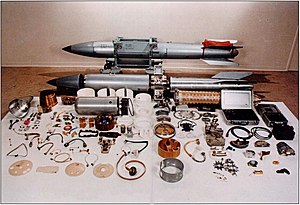Warhead
Jump to navigation
Jump to search

This article includes a list of references, related reading or external links, but its sources remain unclear because it lacks inline citations. (February 2014) (Learn how and when to remove this template message) |

A B61 nuclear bomb in various stages of assembly; the nuclear warhead is the bullet-shaped silver canister in the middle-left of the photograph.
A warhead is the explosive or toxic material that is delivered by a missile, rocket, or torpedo. It is a type of bomb.
Classification[edit]
Types of warheads include:
- Explosive: An explosive charge is used to disintegrate the target, and damage surrounding areas with a blast wave.
- Conventional: Chemicals such as gunpowder and high explosives store significant energy within their molecular bonds. This energy can be released quickly by a trigger, such as an electric spark. Thermobaric weapons enhance the blast effect by utilizing the surrounding atmosphere in their explosive reactions.
- Blast: A strong shock wave is provided by the detonation of the explosive.
- Fragmentation: Metal fragments are projected at high velocity to cause damage or injury.
- Continuous rod: Metal bars welded on their ends form a compact cylinder of interconnected rods, which is violently expanded into a contiguous zig-zag-shaped ring by an explosive detonation. The rapidly expanding ring produces a planar cutting effect that is devastating against military aircraft, which may be designed to be resistant to shrapnel.
- Shaped charge: The effect of the explosive charge is focused onto a specially shaped metal liner to project a hypervelocity jet of metal, to perforate heavy armour.
- Explosively formed penetrator: Instead of turning a thin metal liner into a focused jet, the detonation wave is directed against a concave metal plate at the front of the warhead, propelling it at high velocity while simultaneously deforming it into a projectile.
- Nuclear: A runaway nuclear fission (fission bomb) or nuclear fusion (Thermonuclear weapon) reaction causes immense energy release.
- Conventional: Chemicals such as gunpowder and high explosives store significant energy within their molecular bonds. This energy can be released quickly by a trigger, such as an electric spark. Thermobaric weapons enhance the blast effect by utilizing the surrounding atmosphere in their explosive reactions.
- Chemical: A toxic chemical, such as poison gas or nerve gas, is dispersed, which is designed to injure or kill human beings.
- Biological: An infectious agent, such as anthrax spores, is dispersed, which is designed to sicken or kill humans.
Often, a biological or chemical warhead will use an explosive charge for rapid dispersal.
Detonators[edit]
Type of detonators include:
| Type | Definition |
|---|---|
| Contact | When the warhead makes physical contact with the target, the explosive is detonated. Sometimes combined with a delay, to detonate a specific amount of time after contact. |
| Proximity | Using radar, sound waves, a magnetic sensor, or a laser the warhead is detonated when the target is within a specified distance. It is often coupled with directional explosion control system that ensures that the explosion sends the fragmentation primarily towards the target that triggered it. |
| Remote | Remotely detonated via signal from operator (Not normally used for warheads except for self-destruction). |
| Timed | Warhead is detonated after a specific amount of time. |
| Altitude | Warhead is detonated once it falls to a specified altitude. |
| Combined | Any combination of the above. |
See also[edit]
References[edit]
| Wikimedia Commons has media related to Warheads. |
- The Nuclear Weapon Archive. The B61 (Mk-61) Bomb - Intermediate yield strategic and tactical thermonuclear bomb. [1]
- GlobalSecurity.org The B61 thermonuclear bomb. [2]
- The Brookings Institution. B61 Nuclear Gravity Bomb. [3]
- Stephen I. Schwartz. Atomic Audit - The Costs and Consequences of U.S. Nuclear Weapons Since 1940. Brookings Institution Press 1998 c. 700pp. [4]
- Ogden Air Logistics Center at Hill AFB, Utah. B61 THERMONUCLEAR BOMB. [5]
- National Nuclear Security Administration (NNSA). NNSA Achieves Significant Milestone for B61 Bomb. June 30, 2006. [6]
- Chuck Hansen, U.S. Nuclear Weapons: The Secret History, (New York: Orion Books, 1988), pp. 162–164.